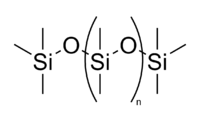J. Allcock & Sons we have been supplying silicone products (silicone oil, silicone emulsion, silicone grease, and more) to many industries since the 1970′s. Therefore we have decided to explain some of┬áthe chemistry behind the two most popular; silicone oil and silicone emulsion. We hope you find it useful.
Silicone Oil
First of all, silicone oil has many different names; silicone fluid, polydimethylsiloxane, dimethicone, dimethylpolysiloxane, dimethyl siloxane, PDMS. J. Allcock & Sons have branded our silicone oil Allcosil 200 (which only adds further to the confusion!)
Technically, we believe that polydimethylsiloxane best describes the oil. Poly (Latin for many), dimethyl (two methyl (CH3) group) siloxane (Silicone and Oxygen).
The chemical structure of polydimethylsiloxane is:

n= number dimethylsiloxane units.
Buyers of polydimethylsiloxane will be aware that it is available in a number of different viscosities. The most common being; 100cSt(centistoke), 350cSt and 1000cSt. The number of dimethylsiloxane units depicts the size of the polymer chain which determines the viscosity. The smaller the polymer chain the lower the viscosity (e.g. 100 cSt) , the bigger the polymer chain the higher the viscosity (e.g.1000cSt).
Our one product in the Allcosil 200 range that is slightly different is our lowest viscosity Allcosil 200; 0.65cSt. Allcosil 200/0.65 has only two units, this means that it is not a polymer, but a dimer. The dimer is hexamethyldisiloxane.
The chemical structure of hexamethyldisiloxane is:
It is clear that when you compare it to the polydimethylsiloxane structure that the dimer is very similar to polydimethysiloxane.
The polymer chain length also has an effect on other properties of the oil.
| Viscosity, cSt | Flashpoint, ┬░C COC | Freezing Point,┬░C | Specific Gravity, @ 25┬░C | Surface Tension, mN/m | Refractive Index, @ 25┬░C |
| 0.65 | -4 | -67 | 0.760 | 15.9 | 1,375 |
| 1 | 40 | -85 | 0.816 | 17.4 | 1,382 |
| 2 | 48 | -90 | 0.830 | 18.1 | 1,387 |
| 3 | 62 | -100 | 0.900 | 18.9 | 1,392 |
| 5 | 136 | -100 | 0.910 | 19.7 | 1,397 |
| 10 | 162 | -65 | 0.930 | 20.1 | 1,399 |
| 20 | 230 | -60 | 0.950 | 20.6 | 1,400 |
| 50 | 280 | -55 | 0.959 | 20.7 | 1,402 |
| 100 | >300 | -55 | 0.965 | 20.9 | 1,403 |
| 200 | >300 | -50 | 0.970 | 21.0 | 1,403 |
| 300 | >300 | -50 | 0.970 | 21.1 | 1,403 |
| 350 | >300 | -50 | 0.970 | 21.1 | 1,403 |
| 500 | >300 | -50 | 0.970 | 21.1 | 1,403 |
| 1000 | >300 | -50 | 0.970 | 21.2 | 1,403 |
| 5000 | >300 | -50 | 0.975 | 21.4 | 1,403 |
| 10000 | >300 | -50 | 0.975 | 21.5 | 1,403 |
| 12500 | >300 | -50 | 0.975 | 21.5 | 1,403 |
| 30000 | >300 | -50 | 0.975 | 21.5 | 1,403 |
| 60000 | >320 | -50 | 0.975 | 21.5 | 1,403 |
| 100000 | >300 | -50 | 0.976 | 21.5 | 1,404 |
| 300000 | >300 | -45 | 0.976 | 21.5 | 1,404 |
| 1000000 | >300 | -40 | 0.976 | 21.5 | 1,404 |
(1000000 cSt, longest polymer chain.)
It is clear from the table showing properties, that after 50cSt, the polymer chain length becomes less important in effecting the properties.
According to the FDA Regulation 21 CFR, certain viscosities are food grade. For more information, please contact us.
Silicone Oils have many uses due to their lubrication, dielectric and water repellent properties.
Silicone Emulsion
Silicone Emulsion contains 3 ingredients; polydimethylsiloxane, emulsifier & water.
The key ingredient is the emulsifier which encapsulates the polydimethylsiloxane oil and holds it in suspension.
A typical emulsifier used in making silicone emulsions is ethoxylated glycol ethers. These emulsifiers have a hydrophobic (dislikes water) and hydrophilic (likes water) part to their structure. The hydrophobic faces the polydimethylsiloxane and the hydrophillic faces the water. This creates a barrier between the water and the polydimethylsiloxane.
Here is a really good picture i found on google. A surfactant (Surface active agent) is just a type of emulsifier.

Unfortunately emulsifiers, due to their chemical make-up, are vulnerable to bacteria. Bacteria can digest certain emulsifiers causing the polydimethylsiloxane to float to the top or disrupt the pH enough for non-digestible emulsifiers to split from the oil. This is called splitting. Splitting in an emulsion can be seen and smelt. The smell comes from the bacterial growth, it usually smells like sour milk.
Emulsions are a key mould realease/lubricant and antifoams for many industries.Our biggest selling emulsion is Allcosil 435 FG, this is sold to the food packaging industry. It is food grade and kosher certified.
If you have any questions, please feel free to leave a comment.


